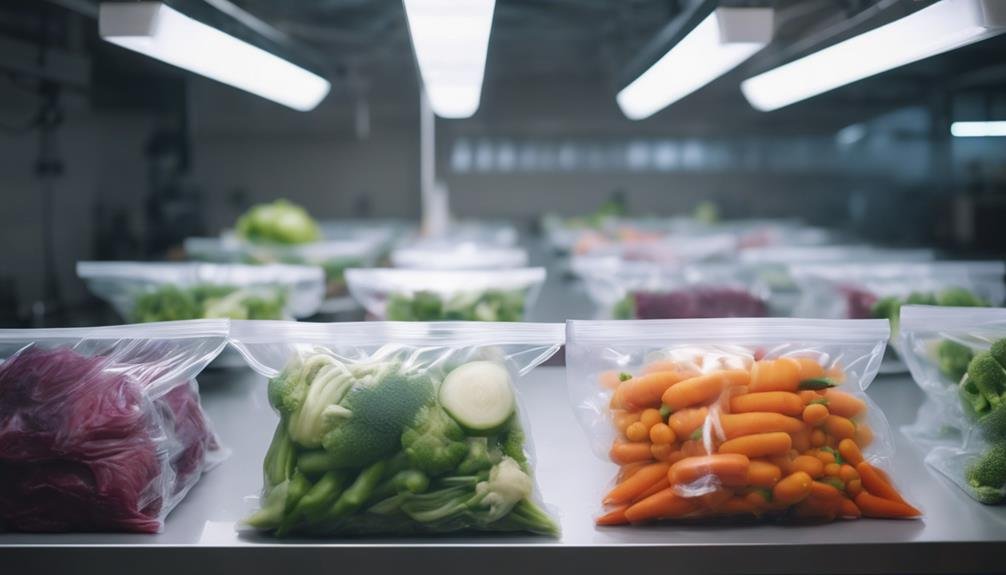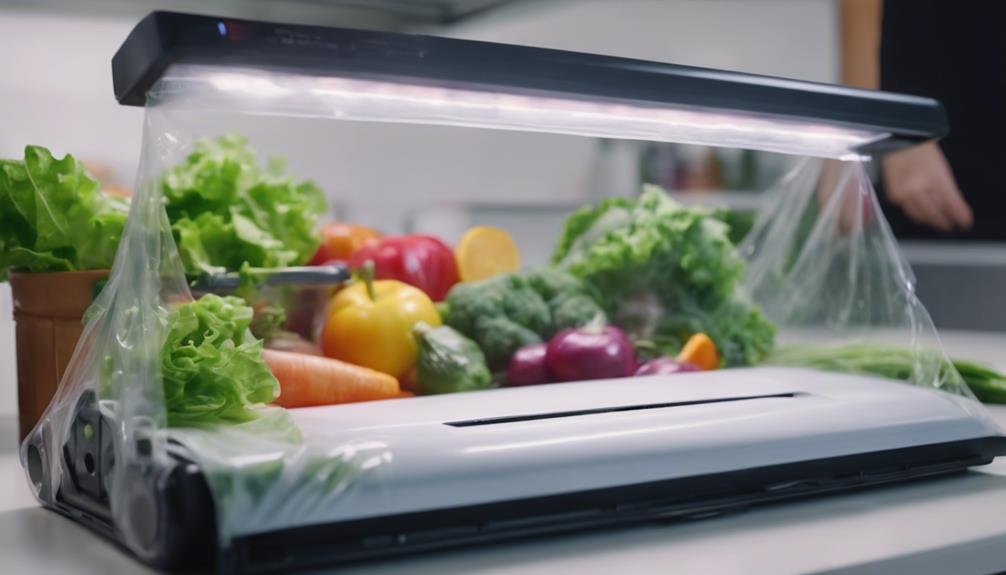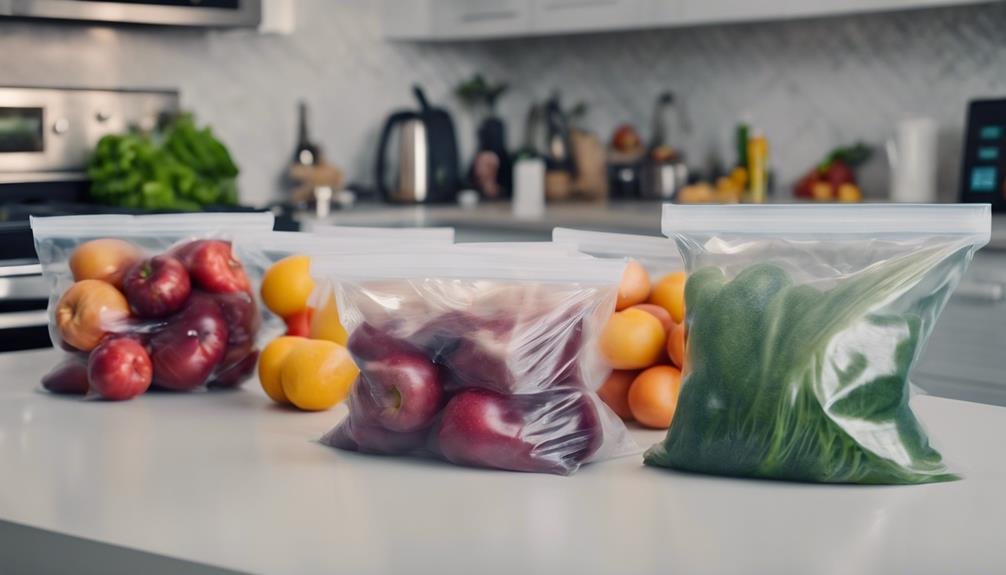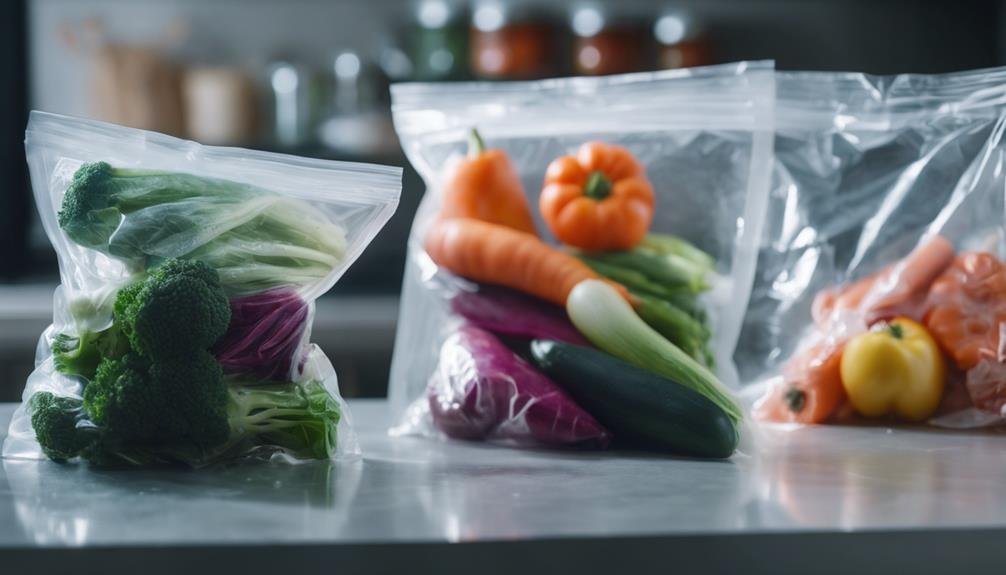Vacuum sealing is an effective way to access antioxidants in your meals. By removing air and creating a protective barrier, it prevents oxidation and preserves the nutritional value of antioxidant-rich foods. You'll maintain the integrity of vitamins C and E, beta-carotene, and polyphenols found in fruits, vegetables, and nuts. To maximize benefits, choose foods like berries, leafy greens, and colorful bell peppers for sealing. Use a vacuum sealer with adjustable settings and gentle suction options for delicate ingredients. Proper storage in the refrigerator or freezer extends shelf life and safeguards important compounds. By understanding the process and avoiding common mistakes, you'll tap into the full potential of vacuum sealing for nutrient preservation.
Understanding Antioxidants
Why are antioxidants so essential for your health, and how can you guarantee you're getting enough of them in your diet? To answer this, you need to understand what antioxidants are and how they function in your body.
Antioxidants are important compounds that play a vital role in protecting your cells from oxidative stress. This stress is caused by free radicals, unstable molecules that can damage your cells and contribute to various health issues. By neutralizing these free radicals, antioxidants help maintain your overall health and well-being.
You can find antioxidants in a wide variety of foods, particularly fruits, vegetables, nuts, and seeds. Common antioxidants include vitamins C and E, beta-carotene, and polyphenols. Each of these compounds offers unique benefits to your body, supporting different aspects of your health.
To make sure you're getting enough antioxidants, it's important to consume a diverse range of antioxidant-rich foods. However, the nutritional value of these foods can degrade over time, especially when exposed to oxygen. That's where vacuum sealing comes in, helping to preserve the antioxidant content of your meals and maximize their health benefits.
Benefits of Vacuum Sealing
Now that you understand the importance of antioxidants, let's explore how vacuum sealing can help you preserve these vital compounds in your meals. Vacuum sealing is an effective food preservation method that offers numerous benefits for maintaining the nutritional value of your food, especially when it comes to antioxidants.
Here's how vacuum sealing helps retain antioxidants in your meals:
- Oxygen removal: By eliminating oxygen from the packaging, vacuum sealing prevents oxidation, which can degrade antioxidants like vitamins C and E.
- Extended shelf life: This method prolongs the freshness of antioxidant-rich foods, allowing you to enjoy their health-promoting properties for longer periods.
- Nutritional preservation: The airtight seal protects antioxidants from degradation, ensuring you get the maximum health benefits from your food.
- Versatility: You can vacuum seal a wide variety of antioxidant-rich foods, including fruits, vegetables, and nuts.
How Vacuum Sealing Works

To understand how vacuum sealing preserves antioxidants in your meals, you'll need to grasp the basic principles behind this innovative food preservation technique. Vacuum sealing works by removing air from the packaging, creating an airtight environment that greatly reduces oxidation. This process is important for maintaining the integrity of antioxidants in your food.
When you vacuum seal your meals, you're basically minimizing their exposure to oxygen. This is essential because oxygen is a key culprit in the degradation of antioxidants. By eliminating air from the package, you're creating a protective barrier that helps preserve these beneficial compounds for longer periods.
The absence of oxygen in vacuum-sealed bags plays an important role in maintaining the freshness and nutritional value of antioxidants present in your food. This method is particularly effective for preserving antioxidants in fruits, vegetables, and other perishable items.
As antioxidants are essential for protecting your cells from damage, vacuum sealing becomes an excellent strategy for ensuring that your meals retain their nutritional benefits. By incorporating this food preservation technique into your routine, you're taking a proactive step towards maintaining the antioxidant content of your meals.
Best Foods for Vacuum Sealing
When it comes to vacuum sealing, certain antioxidant-rich foods are prime candidates for preserving their nutritional value and extending their shelf life. By using this method, you'll protect these foods from exposure to oxygen and light, which can degrade their beneficial properties.
Here are some of the best fruits and vegetables for vacuum sealing:
- Berries (blueberries, strawberries)
- Leafy greens (spinach, kale)
- Cruciferous vegetables (broccoli, cauliflower)
- Colorful bell peppers
By vacuum sealing these antioxidant-packed foods, you're not only preserving their nutritional value but also maintaining their vibrant colors. This technique is particularly effective for berries, which can retain their antioxidant properties longer when sealed properly.
You'll find that your vacuum-sealed produce stays fresher for extended periods, allowing you to enjoy nutrient-rich meals even when these items are out of season.
Choosing the Right Equipment

Selecting the right vacuum sealer is essential for preserving antioxidants in your food and maximizing their nutritional benefits. When choosing a vacuum sealer, you'll want to look for specific features that cater to antioxidant preservation.
Opt for vacuum sealers with adjustable settings, allowing you to customize the sealing process for different types of food. This is particularly important for delicate ingredients rich in antioxidants, as they require gentler handling. Seek out models with gentle suction options to prevent crushing fragile items while still removing air effectively.
A pulse function is another valuable feature, giving you precise control over the sealing process. This allows you to stop and start the suction as needed, ensuring ideal preservation without damaging the food's structure.
Consider vacuum sealers with accessory ports, which enable you to seal jars and containers containing antioxidant-rich foods or liquids. Additionally, some models offer marinating features, perfect for infusing antioxidants deeply into meats or vegetables.
Step-by-Step Sealing Process
Now that you've got the right equipment, let's walk through the step-by-step process of vacuum sealing to preserve those valuable antioxidants in your meals.
By creating an oxygen-free environment, you'll be guaranteeing oxidation prevention and nutritional preservation of your food.
Here's a simple guide to vacuum sealing for antioxidants protection:
- Prepare your food: Clean and dry your ingredients thoroughly to prevent moisture from interfering with the sealing process.
- Place food in the bag: Make sure there's enough space at the top for proper sealing.
- Insert the open end into the vacuum sealer: Position it correctly to achieve an airtight seal.
- Activate the sealer: Follow your machine's instructions to remove air and seal the bag.
Storage and Shelf Life

You'll be amazed at how vacuum sealing can extend the shelf life of your antioxidant-rich foods, keeping them fresh and nutritious for longer periods. By minimizing exposure to oxygen, vacuum sealing greatly slows down oxidation reactions, which are responsible for nutrient degradation. This means you're preserving the nutritional value of your foods, especially those packed with antioxidants.
When you properly seal antioxidant-rich foods like fruits, vegetables, and nuts, you're ensuring that these essential nutrients remain intact during storage. The retention of antioxidants is important, as they play a key role in preventing cell damage and maintaining your overall health. With vacuum sealing, you're creating an environment that's unfriendly to oxidation, allowing your foods to maintain their health benefits for extended periods.
To maximize the benefits of vacuum sealing for antioxidant retention, store your sealed foods in a cool, dark place. This further protects them from light and heat, which can also degrade nutrients.
Nutritional Value Preservation
A staggering 90% of antioxidants in fruits and vegetables can be preserved through vacuum sealing, greatly enhancing the nutritional value of your meals. This preservation technique is particularly effective in protecting vitamins A, C, and E, which are highly susceptible to oxidation. By minimizing exposure to oxygen, vacuum sealing helps maintain the nutritional integrity of your food, guaranteeing you get the most out of every bite.
The benefits of vacuum sealing extend beyond just vitamins. It also safeguards other important compounds that contribute to the overall antioxidant properties of foods, such as polyphenols and flavonoids. This means you're not only preserving taste but also maximizing the health benefits of your ingredients.
To make the most of vacuum sealing for nutritional preservation, consider these tips:
- Seal antioxidant-rich foods like berries, leafy greens, and bell peppers
- Store sealed items in the refrigerator or freezer for extended shelf life
- Use within recommended timeframes to secure the best nutritional value
- Combine vacuum sealing with proper storage temperatures for best results
Common Mistakes to Avoid

While vacuum sealing offers significant benefits for preserving antioxidants, it's important to be aware of common pitfalls that can undermine these advantages. One of the most essential mistakes to avoid is improper sealing, which can lead to oxygen exposure and subsequent antioxidant degradation. To guarantee proper sealing, make sure your vacuum sealer is functioning correctly and the bag is positioned correctly in the machine.
Another common error is overfilling bags, which can prevent a proper seal and compromise the preservation of antioxidants. Leave enough space at the top of the bag for a secure seal to form.
Here's a quick reference table to help you avoid common vacuum sealing mistakes:
| Mistake | Consequence | Prevention |
|---|---|---|
| Improper sealing | Oxygen exposure | Check sealer function |
| Overfilling bags | Poor seal formation | Leave adequate space |
| Using wrong bags | Inadequate vacuum | Use compatible bags |
| Sealing wet foods | Bacterial growth | Pat foods dry first |
| Neglecting maintenance | Sealer malfunction | Clean regularly |
Meal Prep With Vacuum Sealing
Vacuum sealing can revolutionize your meal prep routine by locking in antioxidants and extending the shelf life of your carefully planned dishes. This method of food preservation removes oxygen, the culprit behind oxidation, ensuring that your meals retain their nutritional value for longer periods.
When you incorporate vacuum sealing into your meal prep, you're not just saving time; you're also maximizing the health benefits of your food. The process helps retain nutrients and antioxidants from ingredients like fruits, vegetables, and spices, which might otherwise degrade during storage. By preserving these valuable compounds, you're enhancing the overall nutritional quality of your prepped meals.
To make the most of vacuum sealing in your meal prep routine:
- Choose antioxidant-rich ingredients for your recipes
- Prepare your meals as usual, but avoid adding excess liquids
- Allow hot foods to cool completely before sealing
- Label your vacuum-sealed meals with contents and date
Conclusion
You've mastered the art of vacuum sealing, congratulations!
Now you're a culinary superhero, rescuing antioxidants from the clutches of oxygen villains.
Picture yourself in a cape, wielding your vacuum sealer like Thor's hammer, zapping freshness into every meal.
You're not just preserving food; you're time-traveling nutrients to your future self.
So go forth, oh Mighty Sealer of Sustenance, and may your antioxidants forever remain as perky as a caffeinated squirrel!
